Pietism
| Part ofa serieson |
| Lutheranism |
|---|
 |
| Part ofa serieson |
| Protestantism |
|---|
 |
|
|
Pietism(/ˈpaɪ.ɪtɪzəm/), also known asPietistic Lutheranism,is a movement withinLutheranismthat combines its emphasis on biblical doctrine with an emphasis on individualpietyand living a holyChristianlife.[1][2]
Although the movement is aligned with Lutheranism, it has had a tremendous impact onProtestantismworldwide, particularly in North America and Europe. Pietism originated in modernGermanyin the late 17th century with the work ofPhilipp Spener,a Lutheran theologian whose emphasis on personal transformation through spiritual rebirth and renewal, individual devotion, and piety laid the foundations for the movement. Although Spener did not directly advocate thequietistic,legalistic, and semi-separatist practices of Pietism, they were more or less involved in the positions he assumed or the practices which he encouraged.
Pietism spread from Germany to Switzerland, the rest of German-speaking Europe, and to Scandinavia and the Baltics, where it was heavily influential, leaving a permanent mark on the region's dominant Lutheranism, with figures likeHans Nielsen HaugeinNorway,Peter SpaakandCarl Olof RoseniusinSweden,Katarina AsplundinFinland,andBarbara von Krüdenerin the Baltics, and to the rest of Europe. It was further taken to North America, primarily by German and Scandinavian immigrants. There, it influenced Protestants of other ethnic and other (non-Lutheran)denominationalbackgrounds, contributing to the 18th-century foundation ofevangelicalism,aninterdenominationalmovement within Protestantism that today has some 300 million followers.
In the middle of the 19th century,Lars Levi Laestadiusspearheaded a Pietist revival in Scandinavia that upheld what came to be known asLaestadian Lutheran theology,which is adhered to today by theLaestadian Lutheran Churchesas well as by several congregations within other mainstream Lutheran Churches, such as theEvangelical Lutheran Church of Finland.[3][4]TheEielsen SynodandAssociation of Free Lutheran Congregationsare Pietist Lutheran bodies that emerged in thePietist Lutheran movement in Norway,which was spearheaded byHans Nielsen Hauge.[5]In 1900, theChurch of the Lutheran Brethrenwas founded and it adheres to Pietist Lutheran theology, emphasizing apersonal conversion experience.[6]TheEthiopian Evangelical Church Mekane Yesus,a Lutheran denomination with a largely Pietistic following with somePresbyterianandPentecostalinfluence and primarily based inEthiopiaand among theEthiopian diaspora,is the largest individual member Lutherandenominationwithin theLutheran World Federation.[7]
Whereas Pietistic Lutherans stayed within the Lutheran tradition, adherents of a related movement known asRadical Pietismbelieved inseparatingfrom the established Lutheran Churches.[8]Some of the theological tenets of Pietism also influenced other traditions ofProtestantism,inspiring theAnglicanpriestJohn Wesleyto begin theMethodistmovement andAlexander Mackto begin theAnabaptistSchwarzenau Brethrenmovement.
The wordpietism(in lower case spelling)[9]is also used to refer to an "emphasis on devotional experience and practices", or an "affectation of devotion",[10][9]"pious sentiment, especially of an exaggerated or affected nature",[11]not necessarily connected with Lutheranism or even Christianity.
Beliefs
[edit]Pietistic Lutherans meet together inconventicles,"apart fromDivine Servicein order to mutually encourage piety ".[12]They believe "that any true Christian could point back in his or her life to an inner struggle with sin that culminated in a crisis and ultimately a decision to start a new, Christ-centered life."[12]Pietistic Lutherans emphasize following "biblical divine commands of believers to live a holy life and to strive for holy living, orsanctification".[13]
By country
[edit]Germany
[edit]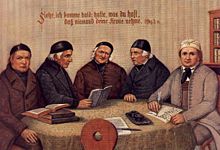
Pietism did not die out in the 18th century, but was alive and active in the AmericanDeutscher Evangelischer Kirchenverein des Westens(German Evangelical Church Society of the West, based inGravois, Missouri,laterGerman Evangelical Synod of North Americaand still later theEvangelical and Reformed Church,a precursor of theUnited Church of Christ.) The church president from 1901 to 1914 was a pietist named Jakob Pister.[14]Some vestiges of Pietism were still present in 1957 at the time of the formation of the United Church of Christ. In the 21st century Pietism is still alive in groups inside theEvangelical Church in Germany.These groups are calledLandeskirchliche Gemeinschaftenand emerged in the second half of the 19th century in the so-calledGemeinschaftsbewegung.
The 19th century saw a revival of confessional Lutheran doctrine, known as theneo-Lutheran movement.This movement focused on a reassertion of the identity of Lutherans as a distinct group within the broader community ofChristians,with a renewed focus on theLutheran Confessionsas a key source of Lutheran doctrine. Associated with these changes was a renewed focus on traditional doctrine and liturgy, which paralleled the growth ofAnglo-Catholicismin England.[15]
Scandinavia
[edit]
InDenmark,Pietistic Lutheranism became popular in 1703.[16]There, the faithful were organized intoconventiclesthat "met for prayer and Bible reading".[16]
Pietistic Lutheranism enteredSwedenin the 1600s after the writings of Johann Arndt, Philipp Jakob Spener, and August Hermann Francke became popular.[17]Pietistic Lutheranism gained patronage underArchbishop Erik Benzelius,who encouraged the Pietistic Lutheran practices.[17]
Laestadian Lutheranism,a form of Pietistic Lutheranism, continues to flourish in Scandinavia, whereChurch of SwedenpriestLars Levi Laestadiusspearheaded the revival in the 19th century.[3]
History
[edit]Forerunners
[edit]As the forerunners of the Pietists in the strict sense, certain voices had been heard bewailing the shortcomings of the church and advocating a revival of practical and devout Christianity. Amongst them were theChristian mysticJakob Böhme(Behmen);Johann Arndt,whose work,True Christianity,became widely known and appreciated;Heinrich Müller,who described thefont,thepulpit,theconfessional,and thealtaras "the four dumb idols of the Lutheran Church"; the theologianJohann Valentin Andrea,court chaplain of the Landgrave of Hesse; Schuppius, who sought to restore the Bible to its place in the pulpit; andTheophilus Grossgebauer(d. 1661) ofRostock,who from his pulpit and by his writings raised what he called "the alarm cry of a watchman inSion".
Founding
[edit]
The direct originator of the movement wasPhilipp Spener.Born atRappoltsweilerin Alsace, now in France, on 13 January 1635, trained by a devout godmother who used books of devotion like Arndt'sTrue Christianity,Spener was convinced of the necessity of a moral and religious reformation within German Lutheranism. He studied theology atStrasbourg,where the professors at the time (and especially Sebastian Schmidt) were more inclined to "practical" Christianity than to theological disputation. He afterwards spent a year inGeneva,and was powerfully influenced by the strict moral life and rigid ecclesiastical discipline prevalent there, and also by the preaching and the piety of theWaldensianprofessor Antoine Leger and the convertedJesuitpreacherJean de Labadie.
During a stay inTübingen,Spener read Grossgebauer'sAlarm Cry,and in 1666 he entered upon his first pastoral charge atFrankfurtwith a profound opinion that the Christian life within Evangelical Lutheranism was being sacrificed to zeal for rigidLutheran orthodoxy.Pietism, as a distinct movement in the German Church, began with religious meetings at Spener's house (collegia pietatis) where he repeated his sermons, expounded passages of theNew Testament,and induced those present to join in conversation on religious questions. In 1675, Spener published hisPia desideriaorEarnest Desire for a Reform of the True Evangelical Church,the title giving rise to the term "Pietists". This was originally a pejorative term given to the adherents of the movement by its enemies as a form of ridicule, like that of "Methodists" somewhat later in England.
InPia desideria,Spener made six proposals as the best means of restoring the life of the church:
- The earnest and thorough study of the Bible in private meetings,ecclesiolae in ecclesia("little churches within the church")
- The Christian priesthood being universal, the laity should share in the spiritual government of the church
- A knowledge of Christianity must be attended by the practice of it as its indispensable sign and supplement
- Instead of merely didactic, and often bitter, attacks on the heterodox and unbelievers, a sympathetic and kindly treatment of them
- A reorganization of the theological training of the universities, giving more prominence to the devotional life
- A different style of preaching, namely, in the place of pleasing rhetoric, the implanting of Christianity in the inner or new man, the soul of which is faith, and its effects the fruits of life
This work produced a great impression throughout Germany. While large numbers oforthodox Lutherantheologians and pastors were deeply offended by Spener's book, many other pastors immediately adopted Spener's proposals.
Early leaders
[edit]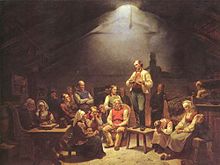
In 1686 Spener accepted an appointment to the court-chaplaincy atDresden,which opened to him a wider though more difficult sphere of labor. InLeipzig,a society of young theologians was formed under his influence for the learned study and devout application of the Bible. Three magistrates belonging to that society, one of whom wasAugust Hermann Francke,subsequently the founder of the famous orphanage atHalle(1695), commenced courses of expository lectures on the Scriptures of a practical and devotional character, and in theGerman language,which were zealously frequented by both students and townsmen. The lectures aroused the ill-will of the other theologians and pastors of Leipzig, and Francke and his friends left the city, and with the aid ofChristian Thomasiusand Spener founded the newUniversity of Halle.The theological chairs in the new university were filled in complete conformity with Spener's proposals. The main difference between the new Pietistic Lutheran school and the orthodox Lutherans arose from the Pietists' conception of Christianity as chiefly consisting in a change of heart and consequent holiness of life. Orthodox Lutherans rejected this viewpoint as a gross simplification, stressing the need for the church and for sound theological underpinnings.
Spener died in 1705, but the movement, guided by Francke and fertilized from Halle, spread through the whole of Middle and North Germany. Among its greatest achievements, apart from the philanthropic institutions founded at Halle, were the revival of theMoravian Churchin 1727 byCount von Zinzendorf,formerly a pupil in Francke's School for Young Noblemen in Halle, and the establishment of Protestant missions. In particular,Bartholomäus Ziegenbalg(10 July 1682 – 23 February 1719) became the first Pietist missionary to India.
Spener stressed the necessity of a new birth and separation of Christians from the world (seeAsceticism). Many Pietists maintained that the new birth always had to be preceded by agonies of repentance, and that only a regenerated theologian could teach theology. The whole school shunned all common worldly amusements, such as dancing, the theatre, and public games. Some believe this led to a new form of justification by works. Itsecclesiolae in ecclesiaalso weakened the power and meaning of church organization. These Pietistic attitudes caused a counter-movement at the beginning of the 18th century; one leader wasValentin Ernst Löscher,superintendentat Dresden.

Establishment reaction
[edit]Authorities within state-endorsed Churches were suspicious of pietist doctrine which they often viewed as a social danger, as it "seemed either to generate an excess of evangelical fervor and so disturb the public tranquility or to promote a mysticism so nebulous as to obscure the imperatives of morality. A movement which cultivated religious feeling almost as an end itself". While some pietists (such as Francis Magny) held that "mysticism and the moral law went together", for others (like his pupil Françoise-Louise de la Tour) "pietist mysticism did less to reinforce the moral law than to take its place… the principle of 'guidance by inner light' was often a signal to follow the most intense of her inner sentiments… the supremacy of feeling over reason".[18]Religious authorities could bring pressure on pietists, such as when they brought some of Magny's followers before the localconsistoryto answer questions about their unorthodox views[19]or when they banished Magny fromVeveyfor heterodoxy in 1713.[18]Likewise, pietism challenged the orthodoxy via new media and formats: Periodical journals gained importance versus the former pasquills and single thesis, traditionaldisputationwas replaced by competitive debating, which tried to gain new knowledge instead of defending orthodox scholarship.[20]
Hymnody
[edit]Later history
[edit]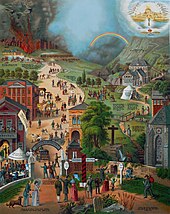
As a distinct movement, Pietism had its greatest strength by the middle of the 18th century; its very individualism in fact helped to prepare the way for theEnlightenment(Aufklärung), which took the church in an altogether different direction. Yet some claim that Pietism contributed largely to the revival of Biblical studies in Germany and to making religion once more an affair of the heart and of life and not merely of the intellect.[citation needed]
It likewise gave a new emphasis to the role of the laity in the church. Rudolf Sohm claimed that "It was the last great surge of the waves of the ecclesiastical movement begun by theReformation;it was the completion and the final form of the Protestantism created by the Reformation. Then came a time when another intellectual power took possession of the minds of men. "Dietrich Bonhoefferof the GermanConfessing Churchframed the same characterization in less positive terms when he called Pietism the last attempt to save Christianity as a religion: Given that for him religion was a negative term, more or less an opposite torevelation,this constitutes a rather scathing judgment. Bonhoeffer denounced the basic aim of Pietism, to produce a "desired piety" in a person, as unbiblical.
Pietism is considered the major influence that led to the creation of the "Evangelical Church of the Union"inPrussiain 1817. The King of Prussia ordered the Lutheran and Reformed churches in Prussia to unite; they took the name "Evangelical" as a name both groups had previously identified with. This union movement spread through many German lands in the 1800s. Pietism, with its looser attitude toward confessional theology, had opened the churches to the possibility of uniting. The unification of the two branches of German Protestantism sparked theSchism of the Old Lutherans.Many Lutherans, calledOld Lutheransformedfree churchesor emigrated to the United States andAustralia,where they formed bodies that would later become theLutheran Church–Missouri Synodand theLutheran Church of Australia,respectively. (Many immigrants to America, who agreed with the union movement, formed German Evangelical Lutheran and Reformed congregations, later combined into theEvangelical Synod of North America,which is now a part of theUnited Church of Christ.)
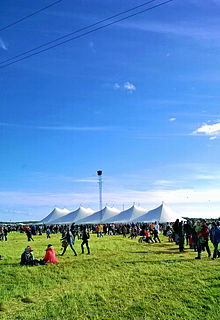
In the middle of the 19th century,Lars Levi Laestadiusspearheaded a Pietist revival in Scandinavia that upheld what came to be known asLaestadian Lutheran theology,which is heralded today by theLaestadian Lutheran Churchas well as by several congregations within mainstream Lutheran Churches, such as theEvangelical Lutheran Church of Finlandand theChurch of Sweden.[3][21]After encountering aSamiwoman who experienced a conversion, Laestadius had a similar experience that "transformed his life and defined his calling".[4]As such, Laestadius "spend the rest of his life advancing his idea of Lutheran pietism, focusing his energies on marginalized groups in the northernmost regions of the Nordic countries".[4]Laestadius called on his followers to embrace their Lutheran identity and as a result, Laestadian Lutherans have remained a part of theEvangelical Lutheran Church of Finland,thenational Churchin that country, with some Laestadian Lutherans being consecrated asbishops.[4]In the United States,Laestadian Lutheran Churcheswere formed for Laestadian Pietists.[4]Laestadian Lutherans observe theLutheran sacraments,holding classical Lutheran theology oninfant baptismand thereal presence of Christ in the Eucharist,and also heavily emphasizeConfession.[22]Uniquely, Laestadian Lutherans "discourage watching television, attending movies, dancing, playing card games or games of chance, and drinking alcoholic beverages", as well as avoiding birth control—Laestadian Lutheran families usually have four to ten children.[22]Laestadian Lutherans gather in a central location for weeks at a time forsummer revival servicesin which many young adults find their future spouses.[22]
R. J. Hollingdale,who translatedFriedrich Nietzsche'sThus Spake Zarathustrainto English, argued that a number of the themes of the work (especiallyamor fati) originated in the Lutheran Pietism of Nietzsche's childhood – Nietzsche's father,Carl Ludwig Nietzsche,was a Lutheran pastor who supported the Pietist movement.[23]
In 1900, theChurch of the Lutheran Brethrenwas founded and it adheres to Pietist Lutheran theology, emphasizing apersonal conversion experience.[6][24]
Pietistic Lutheran denominations
[edit]Pietistic Lutheranism influenced existing Lutheran denominations such as theChurch of Norwayand many Pietistic Lutherans have remained in them, though other Pietistic Lutherans have established their own Synods too. In the middle of the 19th century,Lars Levi Laestadiusspearheaded a Pietist revival in Scandinavia that upheld what came to be known asLaestadian Lutheran theology,which is adhered to today by theLaestadian Lutheran Churchesas well as by several congregations within other mainstream Lutheran Churches, such as theEvangelical Lutheran Church of Finland.[3][4]TheEielsen SynodandAssociation of Free Lutheran Congregationsare Pietist Lutheran bodies that emerged in thePietist Lutheran movement in Norway,which was spearheaded byHans Nielsen Hauge.[5]In 1900, theChurch of the Lutheran Brethrenwas founded and it adheres to Pietist Lutheran theology, emphasizing apersonal conversion experience.[6]
Cross-denominational influence
[edit]Radical Pietism
[edit]Radical Pietism are thoseChristian Churcheswho decided to break with denominationalLutheranismin order to emphasize certain teachings regarding holy living. Churches in the Radical Pietist movement include theMennonite Brethren Church,Community of True Inspiration(Inspirationalists), theBaptist General Conference,members of theInternational Federation of Free Evangelical Churches(such as theEvangelical Covenant Churchand theEvangelical Free Church), theTemplers,theRiver Brethren(inclusive of theBrethren in Christ Church,theCalvary Holiness Church,theOld Order River Brethrenand theUnited Zion Church), as well as theSchwarzenau Brethren(that include Old Order groups such as theOld Brethren German Baptist,Conservative groups such as theDunkard Brethren Church,and mainline groups such as theChurch of the Brethren).[25][26][27][28][29]
Influence on the Methodists
[edit]As withMoravianism,Pietism was a major influence onJohn Wesleyand others who began theMethodist movementin 18th-centuryGreat Britain.John Wesley was influenced significantly byMoravians(e.g.,Zinzendorf,Peter Boehler) and Pietists connected to Francke and Halle Pietism. The fruit of these Pietist influences can be seen in the modern American Methodists, especially those who are aligned with theHoliness movement.
Influence on religion in America
[edit]Pietism had an influence on religion in America, as many German immigrants settled in Pennsylvania, New York, and other areas. Its influence can be traced in certain sectors ofEvangelicalism.Balmer says that:
Evangelicalism itself, I believe, is a quintessentially North American phenomenon, deriving as it did from the confluence of Pietism,Presbyterianism,and the vestiges ofPuritanism.Evangelicalism picked up the peculiar characteristics from each strain – warmhearted spirituality from the Pietists (for instance), doctrinal precisionism from the Presbyterians, and individualistic introspection from the Puritans – even as the North American context itself has profoundly shaped the various manifestations of evangelicalism: fundamentalism, neo-evangelicalism, the holiness movement, Pentecostalism, thecharismatic movement,and various forms of African-American and Hispanic evangelicalism.[30]
Influence on science
[edit]TheMerton Thesisis an argument about the nature of earlyexperimental scienceproposed byRobert K. Merton.Similar toMax Weber'sfamous claimon the link betweenProtestant ethicand thecapitalist economy,Merton argued for a similar positivecorrelationbetween the rise ofProtestantPietism and early experimental science.[31]The Merton Thesis has resulted in continuous debates.[32]
Impact on party voting in United States and Great Britain
[edit]In the United States, Richard L. McCormick says, "In the nineteenth century voters whose religious heritage was pietistic or evangelical were prone to support the Whigs and, later, the Republicans." Paul Kleppner generalizes, "the more pietistic the group's outlook the more intensely Republican its partisan affiliation."[33]McCormick notes that the key link between religious values and politics resulted from the "urge of evangelicals and Pietists to 'reach out and purge the world of sin'".[34]Pietism became influential among Scandinavian Lutherans; additionally it affected other denominations in the United States, such as theNorthern Methodists,Northern Baptists,Congregationalists,Presbyterians,Disciples of Christ,and some smaller groups. The great majority were based in the northern states; some of these groups in the South would rather support the Democrats.[35]
In England in the late 19th and early 20th century, theNonconformistProtestant denominations, such as the Methodists, Baptists and Congregationalists, formed the base of theLiberal Party.[36]David Hempton states, "The Liberal Party was the main beneficiary of Methodist political loyalties."[37]
See also
[edit]| Part of the series on Modern scholasticism | |
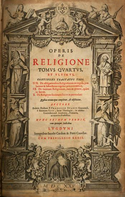
| |
| Title page of the Operis de religione (1625) fromFrancisco Suárez. | |
| Background | |
|---|---|
|
Protestant Reformation | |
| Modern scholastics | |
|
Second scholasticismof theSchool of Salamanca | |
| Reactions within Christianity | |
|
The Jesuits againstJansenism | |
| Reactions within philosophy | |
|
NeologistsagainstLutherans | |
- Amana Colonies
- Adolf Köberle
- Catholic Charismatic Renewal
- Church of the Brethren
- Erik Pontoppidan
- Evangelical Covenant Church
- Evangelical Free Church of America
- Friedrich Christoph Oetinger
- Friedrich Hölderlin
- Johann Georg Rapp
- Hans Adolph Brorson
- Harmony Society
- Henric Schartau
- Immanuel Kant
- Knightly Piety
- Johann Albrecht Bengel
- Johann Konrad Dippel
- Johannes Kelpius
- Mission Covenant Church of Sweden
- Templers (religious believers)
- Theologia Germanica
- Wesleyanism
References
[edit]- ^Backman, Milton Vaughn (1976).Christian Churches of America: Origins and Beliefs.Brigham Young University Press.p. 75.
Pietistic Lutheranism was a form of belief and practice which emphasized experience in the Christian life and championed the importance of Christian action and growth in holiness.
- ^"Pietism".Encyclopædia Britannica.
It emphasized personal faith and sanctity against the main Lutheran church's perceived stress on doctrine and theology over Christian living.
- ^abcdHolmquist, June Drenning (1 January 1981).They Chose Minnesota: A Survey of the State's Ethnic Groups.Minnesota Historical Society Press. p. 306.ISBN9780873511551.
- ^abcdefKivisto, Peter (16 October 2014).Religion and Immigration: Migrant Faiths in North America and Western Europe.Wiley. p. 109.ISBN9780745686660.
- ^abGritsch, Eric W. (1994).Fortress Introduction to Lutheranism.Fortress Press.ISBN9781451407778.
- ^abcTweton, D. Jerome (1988).The New Deal at the Grass Roots: Programs for the People in Otter Tail County, Minnesota.Minnesota Historical Society Press. p. 7.ISBN9780873512336.
- ^M, Eide, Øyvind (1929–1979)."Tumsa, Gudina".Dictionary of African Christian Biography.Retrieved2022-03-20.
{{cite web}}:CS1 maint: multiple names: authors list (link) - ^Granquist, Mark Alan (2015).Lutherans in America: A New History.Augsburg Fortress Publishers.ISBN9781451472288.
- ^ab"Pietism".Dictionary.Retrieved10 September2021.
- ^"Definition of pietism".Merriam Webster Dictionary.Retrieved10 September2021.
- ^"pietism".Lexico.Archived fromthe originalon September 10, 2021.Retrieved10 September2021.
- ^abDawn, Russell P. (15 March 2018)."Piety vs. Pietism".Lutheran Church–Missouri Synod.Retrieved27 September2018.
- ^Granquist, Mark A. (2015).Scandinavian Pietists: Spiritual Writings from 19th-Century Norway, Denmark, Sweden, and Finland.Paulist Press. p. 13.ISBN9781587684982.
- ^A discussion of some of the earlier pietist influence in the Evangelical and Reformed church can be found in Dunn et al., "A History of the Evangelical and Reformed Church" Christian Education Press, Philadelphia, 1962. Further commentary can be found by Carl Viehe under Pietism, Illinois Trails, Washington County.
- ^Scherer, James A. (1993)."The Triumph of Confessionalism in Nineteenth-Century German Lutheran Missions"(PDF).Missio Apostolica.2:71–78. Archived fromthe original(PDF)on January 12, 2006.This is an extract from Scherer's 1968 Ph.D. thesis, "Mission and Unity in Lutheranism". Scherer was Professor of World Mission and Church History at the Lutheran School of Theology at Chicago until his retirement.
- ^abPetersen, Wilhelm W. (2011)."Warm Winds From the South: The Spread of Pietism to Scandinavian Lutherans"(PDF).Bethany Lutheran Theological Seminary.Retrieved27 September2018.
- ^abCollins Winn, Christopher T.; Gerhz, Christopher; Holst, Eric; Carlson, G. William; Heide, Gail (25 October 2012).The Pietist Impulse in Christianity.Casemate Publishers. p. 200.ISBN9780227680001.
- ^abMaurice Cranston (1982).Jean-Jacques: The Early Life and Work of Jean-Jacques Rousseau, 1712–1754.University of Chicago Press.
- ^Leo Damrosch (2005).Jean-Jacques Rousseau: Restless Genius.Mariner Books.
- ^Gierl, Martin (1997).Pietismus und Aufklärung: theologische Polemik und die Kommunikationsreform der Wissenschaft am Ende des 17. Jahrhunderts[Pietism and enlightenment, theological polemic and the reform of science communication end of the 17. century] (in German). Vandenhoeck & Ruprecht.
- ^Elgán, Elisabeth; Scobbie, Irene (17 September 2015).Historical Dictionary of Sweden.Rowman & Littlefield Publishers. p. 159.ISBN9781442250710.
- ^abcLamport, Mark A. (31 August 2017).Encyclopedia of Martin Luther and the Reformation.Rowman & Littlefield Publishers. p. 406.ISBN9781442271593.
- ^Nietzsche, Friedrich(28 February 1974).Thus Spoke Zarathustra.Translated byHollingdale, R. J.Penguin Books Limited. p. 30.ISBN978-0-14-190432-0.
- ^Cimino, Richard (2003).Lutherans Today: American Lutheran Identity in the Twenty-First Century.Wm. B. Eerdmans Publishing. p. 3.ISBN9780802813657.
- ^Shantz, Douglas H. (2013).An Introduction to German Pietism: Protestant Renewal at the Dawn of Modern Europe.JHU Press.ISBN9781421408804.
- ^Smith, James Ward; Jamison, Albert Leland (1969).Religion in American life.Princeton University Press.
- ^Ratliff, Walter R. (2010).Pilgrims on the Silk Road: A Muslim-Christian Encounter in Khiva.Walter Ratliff.ISBN9781606081334.
- ^Carter, Craig A. (2007).Rethinking Christ and Culture: A Post-Christendom Perspective.Brazos Press.ISBN9781441201225.
- ^Melton, J. Gordon; Baumann, Martin (2010).Religions of the World: A Comprehensive Encyclopedia of Beliefs and Practices, 2nd Edition [6 volumes].ABC-CLIO.ISBN9781598842043.
- ^Randall Balmer (2002).The Encyclopedia of Evangelicalism.Westminster John Knox Press. pp. vii–viii.ISBN9780664224097.
- ^Sztompka, 2003
- ^Cohen, 1990
- ^Richard L. McCormick (1988).The Party Period and Public Policy.Oxford UP. pp. 47–48.ISBN978-0-19-536434-7.
- ^McCormick, p 48
- ^Paul Kleppner,The Third Electoral System 1853-1892: Parties, Voters, and Political Cultures(University of North Carolina Press, 1979).
- ^Howard Martin (1996).Britain in the 19th Century.Nelson Thornes. p. 298.ISBN9780174350620.
- ^David Hempton (26 January 1996).Religion and Political Culture in Britain and Ireland: From the Glorious Revolution to the Decline of Empire.Cambridge UP. p. 37.ISBN9780521479257.
- See: "Six Principles of Pietism", based on Philip Jacob Spener's six proposalshttp:// miamifirstbrethren.org/about-us
- Herbermann, Charles, ed. (1913)..Catholic Encyclopedia.New York: Robert Appleton Company.
- Chisholm, Hugh,ed. (1911)..Encyclopædia Britannica.Vol. 21 (11th ed.). Cambridge University Press. pp. 593–594.
Further reading
[edit]- Brown, Dale:Understanding Pietism,rev. ed. Nappanee, IN: Evangel Publishing House, 1996.
- Brunner, Daniel L.Halle Pietists in England: Anthony William Boehm and the Society for Promoting Christian Knowledge.Arbeiten zur Geschichte des Pietismus 29. Göttingen, Germany: Vandenhoeck and Ruprecht, 1993.
- Gehrz, Christopher and Mark Pattie III.The Pietist Option: Hope for the Renewal of Christianity.Downers Grove, Illinois: InterVarsity Press, 2017.
- Olson, Roger E., Christian T. Collins Winn.Reclaiming Pietism: Retrieving an Evangelical Tradition(Eerdmans Publishing Company, 2015). xiii + 190 pp.online review
- Shantz, Douglas H.An Introduction to German Pietism: Protestant Renewal at the Dawn of Modern Europe.Baltimore: Johns Hopkins University Press, 2013.
- Stoeffler, F. Ernest.The Rise of Evangelical Pietism.Studies in the History of Religion 9. Leiden: E.J. Brill, 1965.
- Stoeffler, F. Ernest.German Pietism During the Eighteenth Century.Studies in the History of Religion 24. Leiden: E.J. Brill, 1973.
- Stoeffler, F. Ernest. ed.:Continental Pietism and Early American Christianity.Grand Rapids, MI: Eerdmans, 1976.
- Winn, Christian T. et al. eds.The Pietist Impulse in Christianity.Pickwick, 2012.
- Yoder, Peter James.Pietism and the Sacraments: The Life and Theology of August Hermann Francke.University Park: PSU Press, 2021.
Older works
[edit]- Joachim Feller,Sonnet. In:Luctuosa desideria Quibus[…]Martinum Bornium prosequebantur Quidam Patroni, Praeceptores atque Amici.Lipsiae [1689], pp. [2]–[3]. (Facsimile in: Reinhard Breymayer (Ed.):Luctuosa desideria.Tübingen 2008, pp. 24–25.) Here for the first time the newly detected source. – Less exactly cf. Martin Brecht:Geschichte des Pietismus,vol. I, p. 4.
- Johann Georg Walch,Historische und theologische Einleitung in die Religionsstreitigkeiten der evangelisch-lutherischen Kirche(1730);
- Friedrich August Tholuck,Geschichte des Pietismus und des ersten Stadiums der Aufklärung(1865);
- Heinrich Schmid,Die Geschichte des Pietismus(1863);
- Max Goebel,Geschichte des christlichen Lebens in der Rheinisch-Westfälischen Kirche(3 vols., 1849–1860).
The subject is dealt with at length in
- Isaak August Dorner's and W Gass'sHistories of Protestant theology.
Other works are:
- Heinrich Heppe,Geschichte des Pietismus und der Mystik in der reformierten Kirche(1879), which is sympathetic;
- Albrecht Ritschl,Geschichte des Pietismus(5 vols., 1880–1886), which is hostile; and
- Eugen Sachsse,Ursprung und Wesen des Pietismus(1884).
See also
- Friedrich Wilhelm Franz Nippold's article inTheol. Stud. und Kritiken(1882), pp. 347?392;
- Hans von Schubert,Outlines of Church History,ch. xv. (Eng. trans., 1907); and
- Carl Mirbt's article, "Pietismus," in Herzog-Hauck'sRealencyklopädie für prot. Theologie u. Kirche,end of vol. xv.
The most extensive and current edition on Pietism is the four-volume edition in German, covering the entire movement in Europe and North America
- Geschichte des Pietismus (GdP)
Im Auftrag der Historischen Kommission zur Erforschung des Pietismus herausgegeben von Martin Brecht, Klaus Deppermann, Ulrich Gäbler undHartmut Lehmann
(English:On behalf of the Historical Commission for the Study of pietism edited by Martin Brecht, Klaus Deppermann, Ulrich Gaebler and Hartmut Lehmann)- Band 1:Der Pietismus vom siebzehnten bis zum frühen achtzehnten Jahrhundert. In Zusammenarbeit mit Johannes van den Berg, Klaus Deppermann, Johannes Friedrich Gerhard Goeters und Hans Schneider hg. von Martin Brecht. Goettingen 1993. / 584 p.
- Band 2:Der Pietismus im achtzehnten Jahrhundert. In Zusammenarbeit mit Friedhelm Ackva, Johannes van den Berg, Rudolf Dellsperger, Johann Friedrich Gerhard Goeters, Manfred Jakubowski-Tiessen, Pentii Laasonen, Dietrich Meyer,Ingun Montgomery,Christian Peters, A. Gregg Roeber, Hans Schneider, Patrick Streiff undHorst Weigelthg. von Martin Brecht und Klaus Deppermann. Goettingen 1995. / 826 p.
- Band 3:Der Pietismus im neunzehnten und zwanzigsten Jahrhundert. In Zusammenarbeit mit Gustav Adolf Benrath, Eberhard Busch, Pavel Filipi, Arnd Götzelmann, Pentii Laasonen, Hartmut Lehmann, Mark A. Noll, Jörg Ohlemacher, Karl Rennstich und Horst Weigelt unter Mitwirkung von Martin Sallmann hg. von Ulrich Gäbler. Goettingen 2000. / 607 p.
- Band 4:Glaubenswelt und Lebenswelten des Pietismus. In Zusammenarbeit mit Ruth Albrecht, Martin Brecht, Christian Bunners, Ulrich Gäbler, Andreas Gestrich, Horst Gundlach, Jan Harasimovicz, Manfred Jakubowski-Tiessen, Peter Kriedtke, Martin Kruse, Werner Koch, Markus Matthias, Thomas Müller Bahlke, Gerhard Schäfer (†), Hans-Jürgen Schrader, Walter Sparn, Udo Sträter, Rudolf von Thadden, Richard Trellner, Johannes Wallmann und Hermann Wellenreuther hg. von Hartmut Lehmann. Goettingen 2004. / 709 p.
External links
[edit]- New Schaff-Herzog Encyclopedia of Religious Knowledge, Vol. IX: Pietism
- After Three Centuries – The Legacy of Pietism by E.C. Fredrich
- Literary Landmarks of Pietism by Martin O. Westerhaus
- Pietism's World Mission Enterprise by Ernst H. Wendland
- Old Apostolic Lutheran Church of America
- The Evangelical Pietist Church of Chatfield


